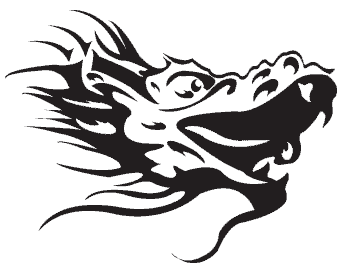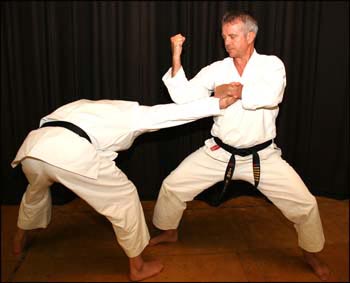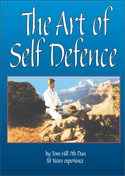Saifa Kata
('To smash & tear' or 'To smash & break')
History of Saifa
Of all the Goju-ryu kaishu kata to be passed down, only Saifa appears to have retained itís original pronunciation in Fujian dialect. Among the Southern Shaolin system in Fuzhou exists a family of boxing systems aptly labeled as ďLion boxingĒ (Japanese; Shishi Kenpo). These include, among others, Lion Form boxing, Golden Lion boxing and Lion boxing.
Several elements of Lion boxing can be specifically seen in Saifa such as the double Hiraken strike and Mawashi uke. The double hiraken strike, according to Kinjo and Tokashiki, represents the pouncing and pulling action of the a lionís front paws as it pulls down itís prey, while the Mawashi uke, although often thought of as the mouth of tiger, can also be interpreted as the mouth of the lion as well. The many stomping actions contained within Saifa represent the powerful steps of the lion.
History maintains that Kanryo Higaonna brought saifa kata back from Fuzhou where he learned the form from Ryu Ryu Ko. However the school of Higaonna's most senior student Juhatsu Kyoda) suggests that only four kata were brought back by Higaonna; Sanchin, Sanseiru, Seisan and Suparinpei (Pichurin).
It seems likely that Chojun Miyagi learned Saifa during his travels in China or perhaps modified it from techniques learned both in China and Okinawa.
Some say Saifa kata has its origins in the Lion systems of Fujian. The original kanji may well have meant 'Lion law', pronounced 'Saifa' in the Hokkien Amoy dialect or "shifa" in Chinese Mandarin. Saifa contains a double punch that is traditionally performed in the 'Lion school'.
It is necessary to consider attacks from the side in order to perform this kata correctly. The (Uchi) striking techniques of Saifa are circular and performed with the joints of the arm, wrist, elbow, and shoulder, all should be free of tension. Only at the point of delivery are the joints locked and the muscles tensed, effectively focusing all your power at the point of impact (kime).
Siafa is the first of the advanced kaishu, or "open hand" kata, the classical combative Kata taught in Goju-Ryu. Kanryo Higaonna Sensei was taught this Kata, along with other Kata of Goju-Ryu, while he studied in China from 1863-1881 under the teaching of Ru Ru Ko and others.
The name of this kata uses the same Chinese kanji character as for the 'sai' found in gekisai kata. The second kanji character 'fa' means to tear or rip. It can therefore be translated to mean 'to smash & tear'. It is pronounced 'Sui-po' in Mandarin Chinese, 'Sai-fa' in Okinawan dialect and 'Sai-ha' in Japanese. It contains quick whipping motions, hammer fists and back fist strikes along with kicks using the knee and kicks to the groin; it shows a moving vector from an opponent's direction, while closing distance and attacking.
For an understanding of the grappling and striking techniques of Saifa it can be interpreted to mean grabbing and tearing of tissue in close-quarter combat.
It is thought that this kata uses techniques from the White Crane and Tiger or possibly Lion systems. It mixes swift, light stances; Neko ashi dachi & Sagi ashi dachi with solid, groundied stances such as Shiko dachi.

Warning:
If you perform any technique shown here in class or in public, you do so at your own risk.
We assume no responsibility for the use or misuse of the information provided which results in injury or loss.
Copyright: Tom Hill 2012 Goju.co.uk All rights reserved.
UPDATED 1st AUG 2020


































